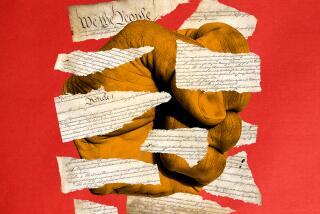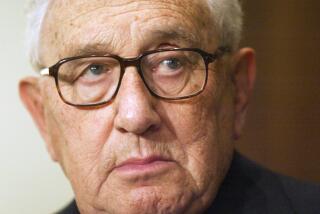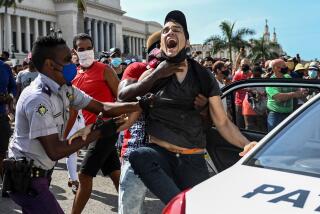Op-Ed: Another reason to remember 1968: the 50th anniversary of the beginning of the end of Communism
- Share via
Fifty-year anniversaries of the shocks of 1968 pour down: the Tet Offensive and the My Lai massacre in Vietnam, the assassinations of Martin Luther King Jr. and Robert Kennedy, riots and demonstrations galore. All eminently deserve remembrance. But violent eruptions weren’t the whole story of that fateful year. On a global scale, 1968 was also the beginning of the end of Communism as a left-wing ideal.
During the preceding half-century, despite all of Communism’s recorded crimes, Marxist-Leninist revolutionaries had remained committed to the absolute rule of a single party as the only viable remedy for capitalism. Around the world, Soviet-style governments enjoyed a reputation as the best imaginable route to social progress, and even in Western Europe national Communist parties mattered. Then actual Communists of different stripes did a demolition job on their own world views. The notion that an autocratic superstate was the next and most desirable stage of history was battered beyond repair. After 1968, only the most blinded of the faithful could still be true believers.
In the course of the year, four versions of Communist leadership were gravely discredited — in France, Czechoslovakia, Cuba and China.
When 1968 began, the French Communist Party was politically powerful but not exactly revolutionary. The students who rose up that spring against university authorities, police and capitalism in general owed no loyalty to the unreconstructed Stalinists in the calcified party. Communist-led unions supported a general strike in May 1968, but they were after conventional things like better wages and working conditions, not a total overhaul of society.
After 1968, Communism looked and felt passe.
In fact, the French party vehemently opposed the students, led by anarchists and ultraleftists, when they pried cobblestones from Paris streets, built barricades and fought the police on behalf of a dimly glimpsed utopia. After the May uprisings were put down, radicals and the intellectual left condemned the Communists as de facto conservatives who were fronting for capitalism. Communism lost what remained of its luster in France. The party went into a steep decline from which it never recovered.
On the other side of the Iron Curtain, in the spring of 1968, dissidents in Czechoslovakia were rejoicing. They thought they had found a way to liberate Communism from one-party dictatorship. Hoping to extend democracy and liberalize culture without overturning social ownership of the economy, they attempted to create “socialism with a human face” — terminology that recognized the existing system was far from human.
Under the leadership of the Czechoslovak Communist Party chairman, Alexander Dubcek, the government began to implement what became known as Prague Spring. Freedom sprouted: miniskirts on girls, long hair on boys. Banned books, films and plays emerged from the underground. Alarmed, in August, the Soviet Union and its satellites sent in 200,000 troops, literally crushing the reformers and their reform ideals. When dissidents rose again in 1989 to put an end to Communism, it was in the name of democracy and freedom, not socialism, whatever its face.
Meanwhile, in Cuba, Fidel Castro had managed to inherited the internationalist mantle of his co-revolutionary Ernesto “Che” Guevara, martyred by the CIA in 1967 during his quixotic effort to instigate a peasant revolt in Bolivia. Because Castro made moves toward independence, the USSR responded by cutting off the island’s oil supplies. Playing tit for tat, Castro began 1968 by arresting a pro-Soviet “microfaction.” But then he fell in line with the Soviet invasion of Czechoslovakia, warning against “fascist reactionary rabble” who were moving Prague toward capitalism and into “the arms of imperialism.”
As Castro grew more repressive at home, his international support withered and his revolutionary aura dissipated. The leftist mystique transferred back to the dead Che, who lingered in the dreams of young radicals like a sort of Cheshire cat. It only later became clear that by cultivating fantasies of successful guerrilla wars, the Cuban leadership condemned a whole generation of revolutionaries to death and failure.
Increasingly, leftists’ search for a revolutionary lodestone turned to an imaginary version of China as an alternative to Soviet authoritarianism. Accurately perceiving that Mao was no ally of the Soviet Union, they construed Maoism to be purified Communism. But in 1968 and the years to come, the Cultural Revolution crushed such innocent fancies.
Mao, who mobilized millions of youthful Red Guards to fight his enemies in the party, dispatched them to the countryside where their assaults on “class enemies” would leave many disillusioned. In time, Mao’s radicalism would be exposed as a murderous facade for totalitarian power. After his death, the party would scramble back, but what now passes as Chinese Communism is a cynical, paper-thin ideological escort for great-power capitalism wedded to a dictatorship — not a revolutionary ideal at all.
It took a while for the glow to fully fade, but after 1968, Communism looked and felt passe. Even radicals disdained Communist parties — as fuddy-duddies, counter-revolutionaries, shields for Soviet imperialism or all three.
Soon the only Communist state that sustained revolutionary esteem was North Vietnam, which for a while held onto its aura of nobility and idealism, albeit for a negative reason: It had withstood America’s ignoble war. Few of today’s dissidents worship or rationalize power, however revolutionary its rhetoric. They undermine the authorities and revel in decentralization. When they seek inspiration, they usually find it in anarchism — the ancestral bane of a Communism that is now not only obsolete but toxic.
Todd Gitlin is a professor of journalism and sociology at Columbia University and the author of “The Sixties: Years of Hope, Days of Rage” and 16 other books.
Follow the Opinion section on Twitter @latimesopinionand Facebook
More to Read
A cure for the common opinion
Get thought-provoking perspectives with our weekly newsletter.
You may occasionally receive promotional content from the Los Angeles Times.










